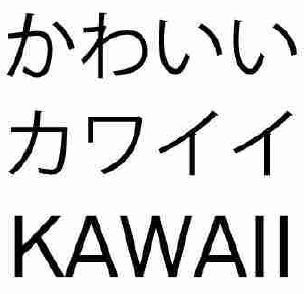2021.03.30
Appeal decision report – “cawaii” was allowed to be registered because “cawaii” and the cited trademark “KAWAII, and KAWAII written in Hiragana and Katakana” are dissimilar
March 30, 2021
Noriko Yashiro
| Appeal number | Rejection 2020-7842 (JP Appl. No. 2018-147178) |
|---|---|
| Case summary | “cawaii” is allowed to be registered because “cawaii” and the cited trademark “ ” are considered dissimilar. ” are considered dissimilar. |
| Date of decision | February 15, 2021 |
| Demandant (Applicant) | onepeace.Ltd |
| Trademark(s) |
Applied-for-trademark: cawaii Cited trademark: |
| Designated Goods/Services and Class(es) |
Designated Goods/Services and Class of applied-for-trademark: Clothing; collars [clothing]; garters; sock suspenders; suspenders [braces]; waistbands; belts [clothing]; footwear [other than special footwear for sports]; masquerade costumes; clothes for sports; special footwear for sports in class 25 |
| Judgement |
(1) Applied-for-trademark: The applied-for-trademark consists of Roman letters “cawaii” as standard characters. The letters “cawaii” do not form a word listed in dictionaries and the like. The appeal examiners did not find that the letters have a specific meaning. Thus, it is reasonable to say that the letters should be considered as a coined word and that the letters should be pronounced as “ca-wa-i-i ” according to how to commonly read Roman letters in Japan or how to read letters in English and that the letters do not have any specific meaning. (2) Cited trademark: The cited trademark is a justified and tri-level trademark consisting of “KAWAII in hiragana”, “KAWAII in katakana” and “KAWAII in Roman letters”. The portion “KAWAII in hiragana” has a meaning of “adorable; little and pretty”. It is reasonable to say that the portions “KAWAII in katakana” and “KAWAII in Roman letters” would be naturally recognized as representations, in different letter types, of “KAWAII in hiragana”. As such, the cited trademark should have a pronunciation of “KA-WA-I-I” and a meaning of “adorable; little and pretty” because it is reasonable to say that traders and consumers should merely recognize that the portions “KAWAII in katakana” of the second line and “KAWAII in Roman letters” of the third line are representations, in different letter types, of “KAWAII in hiragana” of the first line of the cited trademark. (3) Similarity of the applied-for-trademark and the cited trademark: As we discussed the compositions of the applied-for-trademark and the cited trademark (1) and (2) above, the trademarks are clearly different in appearance as a whole. (4) Conclusion: As we discussed above, the applied-for-trademark and the cited trademark are dissimilar regardless of whether the designated goods of the trademarks are similar. Thus, the refusal decision in the examination stage should be withdrawn. |
| Comments |
In addition to the citation above, the applied-for-trademark was judged indistinctive in examination stage because traders and consumers would merely recognize “adorable, little and pretty goods” when the applied-for-trademark is used on the designated goods. However, the judgement was withdrawn because the applicant argued that traders and consumers should recognize that the applied-for-trademark is a kind of coined word having a special spelling and that the applied-for-trademark is well-distinguished. |